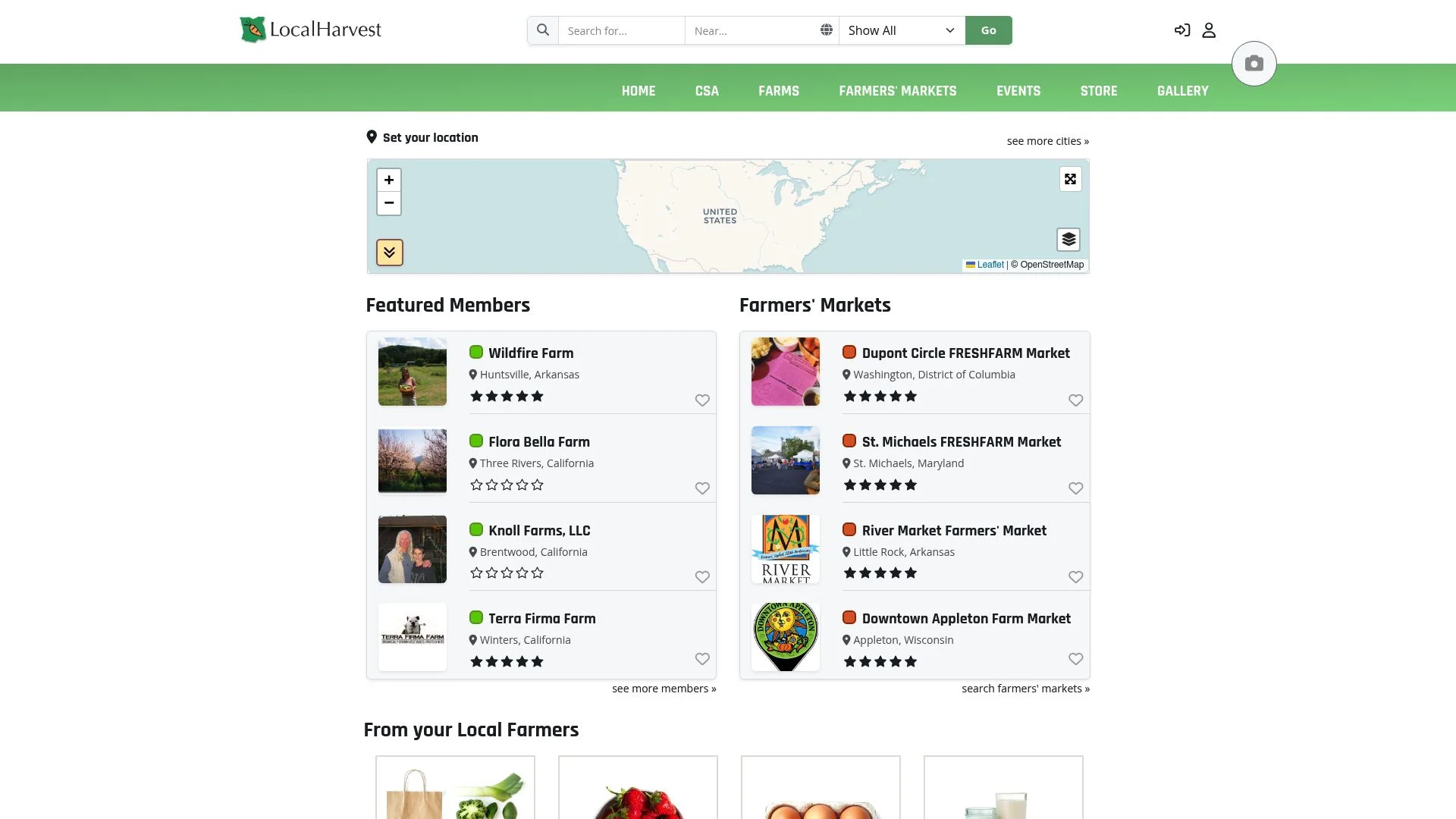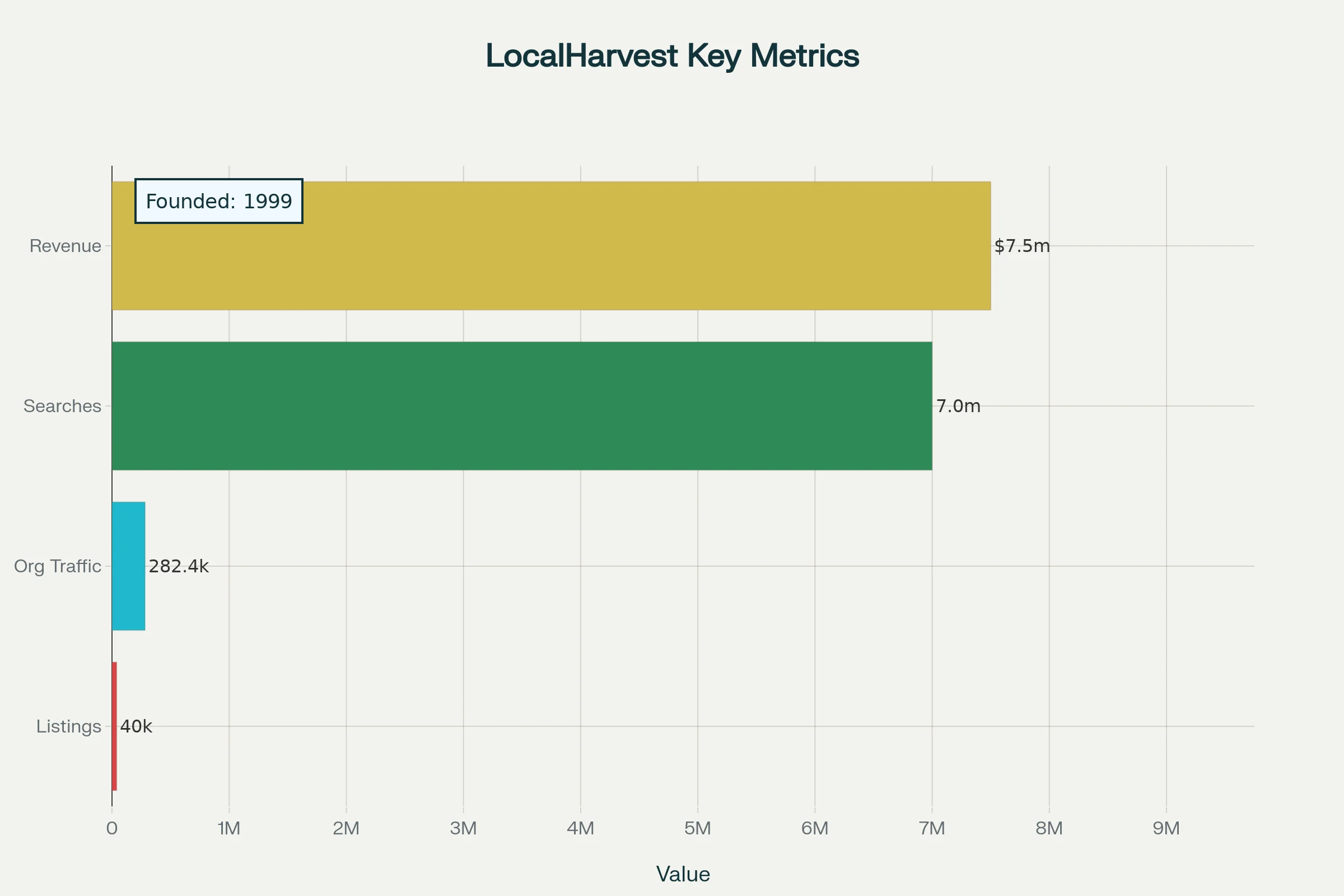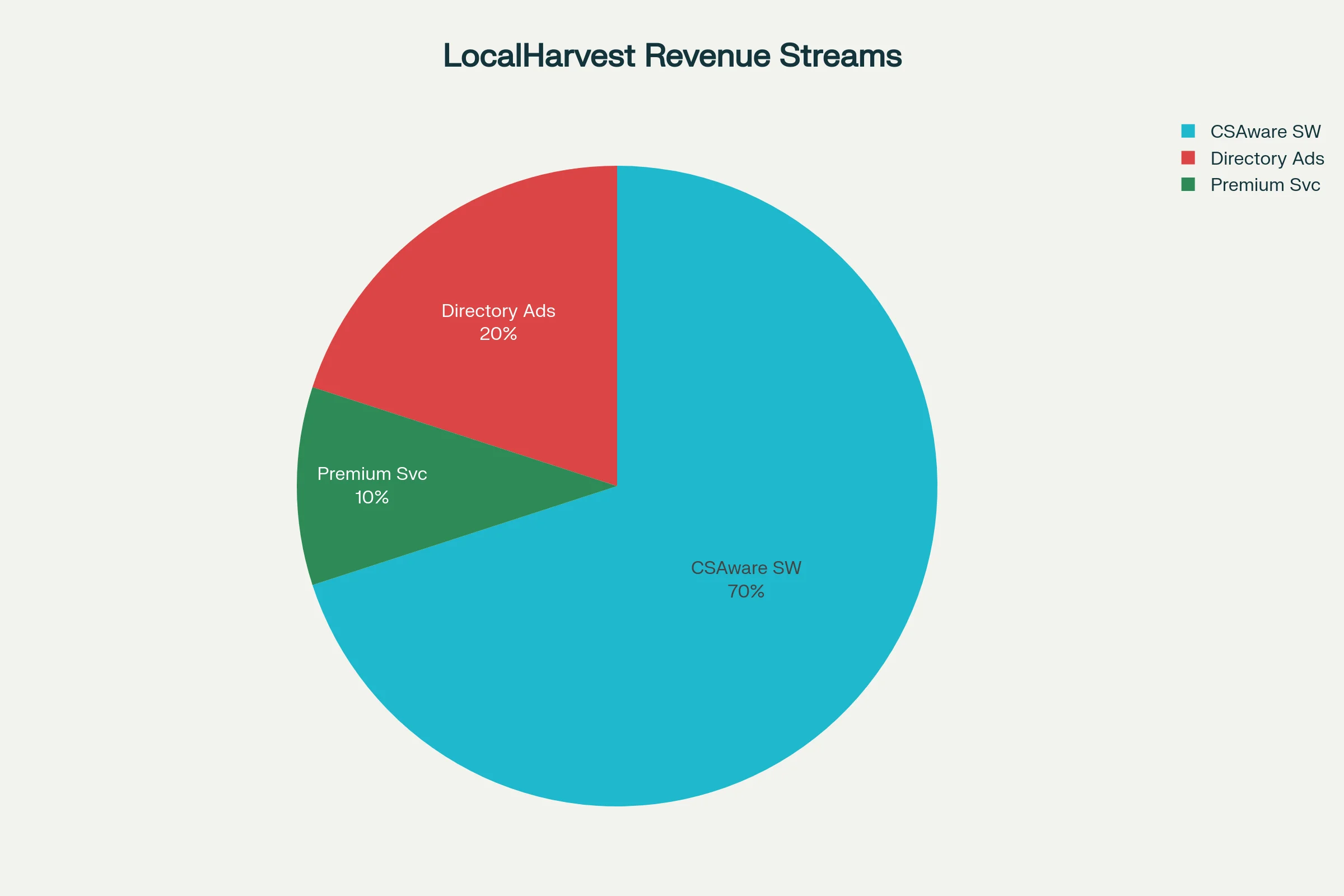25 Years, $7.5M Revenue: The Directory-to-SaaS Playbook That Actually Works

I discovered LocalHarvest while looking for a CSA near my home. After searching "community supported agriculture" online, I found this incredible directory that connected me with local farms offering fresh produce subscriptions. That's when I realized LocalHarvest wasn't just another website—it was America's most trusted bridge between people who want good food and farmers who grow it.
Founded in 1999 by software engineer Guillermo Payet, LocalHarvest started with a simple mission: make it easy for people to find local food while supporting family farms. What began as a community project has grown into the nation's largest local food directory, serving over 7 million searches annually across 40,000+ farm listings.
The genius is in the community approach: Instead of trying to compete with big food websites, LocalHarvest focused on something specific—connecting people with local farmers. This focus created a sustainable business generating an estimated $7.5 million annually while serving 282,400 monthly visitors who genuinely care about where their food comes from.
1. Directory Overview
| Company Profile | Details |
|---|---|
| Name | LocalHarvest |
| URL | https://localharvest.org |
| Niche/Problem Solved | America's #1 organic and local food website |
| Year Founded | 1999 |
| Current Monthly Visitors | 282.4K |
Estimated Annual Revenue
- Annual Revenue: $7.5M (according to ZoomInfo)
- Employees: 11-50
- Revenue per Employee: $150K-$680K
- Business Model: Freemium directory + B2B software services
Estimated Annual Revenue: $7.5M
Note: This revenue estimate reflects LocalHarvest's dual business model combining free directory services with premium CSAware software subscriptions. The company's longevity and market leadership suggest stable, recurring revenue streams from both consumer and B2B segments.
2. Traffic and Growth Analysis
Monthly Traffic Overview
Total Monthly Traffic
282.4K
Annual Searches
7M+
Directory Performance
Total Listings
40K+
Category Rank
#576
Years Active
25

Traffic Sources
Growth Drivers
First-Mover Advantage: As one of the earliest online local food directories, LocalHarvest established itself as the definitive resource before competition emerged, building deep brand recognition and trust within both farming and consumer communities.
Grassroots Community Building: Unlike venture-funded competitors, LocalHarvest's organic growth model fostered authentic relationships with family farms and local food advocates, creating a sustainable network effect that drove word-of-mouth growth.
Dual Value Proposition: The platform simultaneously serves consumers seeking local food and farmers needing business management tools, creating multiple touchpoints for user acquisition and retention across different market segments.
Educational Content Strategy: Through blogs, newsletters, and educational resources about CSA, sustainable farming, and local food systems, LocalHarvest positioned itself as an authority, driving organic search traffic and community engagement.
Geographic Network Effects: As more farms joined in each region, the directory became increasingly valuable to local consumers, creating positive feedback loops that strengthened LocalHarvest's market position in established areas.
Technology Integration: The development of CSAware software created a recurring revenue stream while deepening relationships with farm partners, ensuring long-term platform stickiness and reducing churn.
🌱 Want More Directory Success Stories?
Get weekly insights on profitable directories, growth strategies, and monetization tactics delivered to your inbox.
Subscribe to Directory Gems
3. Monetization Strategy
Primary Revenue Streams

CSAware Software Subscriptions: LocalHarvest's flagship B2B product generates recurring revenue through a software-as-a-service model, charging farmers 2% of sales with a $100 monthly minimum. This business management platform helps CSA farms manage subscriptions, deliveries, and customer communications while creating strong customer retention.
Free Directory with Premium Features: The core directory remains free to maintain network effects, but enhanced listings, featured placements, and premium farm profiles generate advertising-style revenue from farms seeking greater visibility.
Strategic Partnership Revenue: LocalHarvest partners with organic certification bodies, agricultural organizations, and sustainable food companies, generating revenue through referral fees, sponsored content, and co-marketing arrangements.
Educational Content and Consulting: The platform leverages its expertise in local food systems to offer consulting services, premium educational content, and speaking engagements, diversifying revenue beyond the core directory.
The freemium model proves particularly effective in the agricultural sector, where farmers appreciate free basic listings but willingly pay for tools that directly impact their business operations and customer relationships.
4. SEO and Content Strategy
SEO Authority Metrics
Domain Age
25 years
Directory Size
40K+ listings
Category Position
#576
Content Performance
Monthly Searches
7M+
User-Generated Content
40K+ profiles
Top Ranking Keywords
Keywords driving organic traffic (estimated)
| Keyword | Search Intent | Content Type |
|---|---|---|
| csa near me | Local Discovery | Directory Search |
| farmers market [city] | Local Discovery | Location Pages |
| community supported agriculture | Educational | Educational Content |
| local farm [location] | Local Discovery | Farm Profiles |
| organic farms near me | Local Discovery | Directory Search |
Top Organic Competitors
Sites competing for similar keywords
| Competitor | Focus Area | Key Differentiator |
|---|---|---|
| eatwellguide.org | Sustainable food directory | Restaurant focus |
| farmfreshtoyou.com | Farm delivery service | Direct delivery model |
| harvie.farm | CSA marketplace | Modern tech platform |
| usda.gov | Government directory | Official USDA data |
| ams.usda.gov | Agricultural marketing | Federal programs |
On-Page SEO Strategy
LocalHarvest built exceptional SEO authority through a comprehensive, long-term approach:
Domain Age Advantage: With 25 years of continuous operation since 1999, LocalHarvest enjoys significant domain authority and trust signals that newer competitors cannot easily replicate, particularly valuable for local search algorithms.
User-Generated Content at Scale: The 40,000+ farm and market listings create a massive repository of location-specific, frequently updated content that serves both users and search engines seeking fresh, relevant local information.
Long-Tail Local Keyword Domination: By enabling farms to create their own listings with location-specific details, LocalHarvest automatically captures thousands of long-tail local keywords like "organic farm [city name]" and "CSA [neighborhood]".
Educational Content Authority: The platform's blog, CSA guides, and educational resources establish topical authority around sustainable agriculture, community-supported agriculture, and local food systems.
Geographic Coverage: With listings across all 50 states, LocalHarvest captures search traffic for local food queries nationwide, creating a comprehensive geographic SEO footprint that individual farms cannot match.
Technical SEO Excellence: Clean URL structures, fast loading times, and mobile optimization ensure strong technical foundations, while the directory's age and consistent updates provide powerful freshness signals.
5. Lessons and Opportunities
Why LocalHarvest is Unbeatable
25-Year Head Start: LocalHarvest's quarter-century of operation creates insurmountable advantages—domain authority, community trust, and comprehensive coverage that competitors can't quickly replicate.
Network Effects: The platform becomes more valuable as more farms and consumers join. Each new farm listing attracts more customers, and each new customer makes the directory more attractive to farms.
Dual Revenue Streams: By combining free directory services with paid CSAware software, LocalHarvest creates multiple ways to monetize the same community while reducing dependency on any single revenue source.
Mission-Driven Community: Deep relationships with sustainable agriculture advocates create strong brand loyalty and word-of-mouth growth that pure commercial competitors struggle to match.
Key Opportunities
Mobile App: A dedicated app could enhance location-based discovery and provide offline access to farm information.
E-commerce Integration: Deeper integration with farm online stores could enable unified shopping across multiple local producers.
Data Analytics: Leveraging 25 years of local food data to provide market insights to farms and researchers.
International Expansion: Adapting the successful U.S. model to other countries with growing local food movements.
Main Risks
Over-Commercialization: Balancing revenue growth with grassroots community values.
Technology Debt: The platform's long history may require significant updates to remain competitive.
Seasonal Revenue: Agricultural patterns create cash flow challenges during off-peak periods.
6. Actionable Takeaways
1. Build Network Effects Early: Create value for both sides of your marketplace—consumers and suppliers. Each group makes the platform more valuable for the other.
2. Focus on Community, Not Competition: Build authentic relationships with your niche community rather than trying to compete with everyone.
3. Let Users Create Content: Enable users to build and maintain their own listings. This reduces your costs while creating fresh, location-specific content.
4. Develop Multiple Revenue Streams: Don't rely on just one way to make money. LocalHarvest combines free directory services with paid software subscriptions.
5. Play the Long Game: Domain age and consistent operation provide SEO advantages that compound over time. Patience beats quick wins.
Conclusion
Here's what I learned from LocalHarvest: Sometimes the best business ideas are hiding in plain sight.
When I discovered LocalHarvest while searching for a CSA near my home, I realized there was a whole world of local food connections that most people couldn't access. LocalHarvest's founder saw the same opportunity 25 years ago and built something remarkable.
The lesson? Don't try to compete with everyone. Instead, find a passionate community with a real problem and become their go-to solution.
LocalHarvest didn't try to be the biggest food website—they just wanted to connect people with local farmers. That focus created a defensible business generating $7.5 million annually while serving 282K+ monthly visitors who genuinely care about where their food comes from.
My takeaway for directory builders: Look for the gaps that passionate communities face. Then build the definitive resource to fill that gap. It's often better to be the expert in a small niche than to be average in a big market.
The secret to LocalHarvest's success? They found their community and served them authentically for 25 years.
🚀 Ready to Build Your Own Directory?
Join 80+ entrepreneurs getting actionable insights on directory businesses, case studies, and proven growth tactics.
Get Free Directory Insights